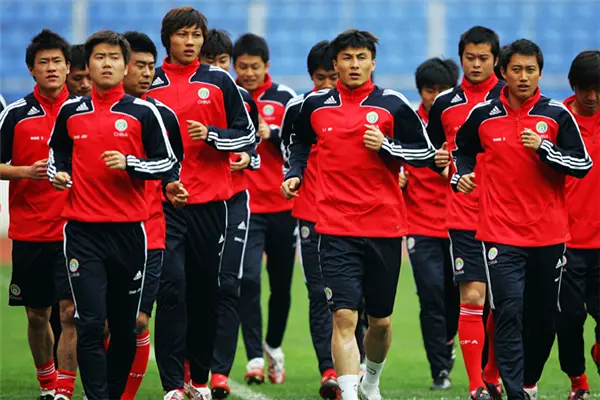Chinese soccer players' transfer fees have climbed up much faster than the national team did in the FIFA world rankings.
Twenty-two years after the Chinese soccer league turned professional, the transfer fees for Chinese domestic stars ballooned by over 100 times to match those of first class players in Europe and South America.
In the meantime, the national team stands 82nd in the latest FIFA world rankings and has an average position of 71st since the world rankings were established in 1993.
Less than two weeks ago, a domestic transfer record was set by second tier club Quanjian who bought Chinese Super League (CSL) club Liaoning Whowin's Zhang Lu with 70 million yuan (about 9.85 million euros).
The number was more than 100 times of that for top players back in 1995 when the Chinese soccer league was in its second year of professionalization. The most expensive player on that year's transfer market was international striker Li Bing who joined Guangdong from Liaoning on 640,000 yuan (about 90,000 euros).
Zhang's transfer fee beat former mark set in last year when Chinese international Sun Ke's move from top flight CSL side Jiangsu to Tianjin was put on a 66 million yuan price tag.
Although Zhang, a 29-year-old goalkeeper who could not secure the first-choice position in the national team, is lesser known, his price almost equals that of Germany defender Matthias Ginter when the youngster joined Bundesliga side Borussia Dortmund on a 10-million-euro deal in 2014.
Many were concerned that the transfer market was filled with bubbles.
"The Chinese national team has yet to stand on the top of Asia but the players are more expensive than some famous foreign players. Clearly their prices have gone far beyond their true values while bubbles and false prosperity prevail in Chinese soccer," commented News Morning, a newspaper based in Shanghai.
A large part of the media thought the "bubbles" stemmed from the combination of small number of quality players at home and foreign player quota.
"It is the reflection of supply and demand in Chinese soccer market. Due to the foreign player quota, clubs are forced to dig deep in domestic talent pool, which unfortunately is very limited in size," said City Evening News, a newspaper based in China's northeast province Jilin.
Some people blamed CSL champions Guangzhou Evergrande for jacking up the prices.
Evergrande, crowned the CSL title five times in a run since its promotion to the top league in 2011, has been known for its huge spendings on the transfer market.
"In the past few years, Evergrande has spent a great deal to buy players at home and abroad. Now its hoarding shows its value as other clubs are fighting for these players," said Chinanews.com.
Last Friday, Evergrande sold 31-year-old international midfielder Zhao Xuri to Quanjian on a reported transfer fee of no less than 70 million yuan. The Guangzhou team brought in Zhao four years ago with 7 million.
As a matter of fact, Chinese clubs' shopping spree was not limited to the domestic market as they also are generous buyers in Europe and South America, especially in Brazil.
In 2011, Dario Conca's decision to join Evergrande attracted little fanfare in a football world whose axis has always been heavily tilted towards Europe.
Five years later, the Argentine playmaker's 9.1 million euros move from Brazil's Fluminense can be seen as a defining moment in the rapid emergence of the CSL.
A steady stream of Brazilians have followed in Conca's footsteps, with the number multiplying in recent months.
Among current and former Brazil internationals lured by Chinese clubs in the past year are Diego Tardelli (Shandong Luneng), Robinho (Guangzhou Evergrande), Paulinho (Guangzhou Evergrande), Ricardo Goulart (Guangzhou Evergrande), Jadson (Tianjin Songjiang), Luis Fabiano (Tianjin Songjiang) and Renato Augusto (Beijing Guoan).
According to Tardelli, the stratospheric salaries paid by Chinese clubs have made their proposals too good to refuse.
"It changes your financial life," he told Globoesporte. "It's great to play in Brazil with the fans and the constant pressure to perform. But the salaries in China are higher and they are paid on time. I'm 30 years old and I have to think about my future."
Corinthians are the Brazilian outfit that have suffered most from China's thirst for world-class players.
The 2015 Brazilian Serie A champions have already lost Jadson and Renato Augusto in the past month with Alexandre Pato, Ralf, Elias and Cassio also considering offers from CSL sides.
"We have been surprised by their departures," Corinthians president Roberto de Andrade said.
"Chinese clubs work differently. They offer huge salaries and there is no way to prevent players from leaving. We could lose five, six or seven of them."
The clubs also reached out for players in European clubs.
On Tuesday, newly promoted CSL club Hebei announced that Cote d'Ivoire international Gervais Yao Kouassi joined them from Italian Serie A side Roma.
"Spending, spending and spending. Whether bubbles or prosperity, China's CSL has definitely become the most noticeable league in the world, although the national team is still struggling to qualify for the next phase of the 2018 World Cup Asian Zone qualifying round," said the New Cultural newspaper on Tuesday.
The overflowing money in Chinese soccer came as a result of investment enthusiasm which has grown rapidly since 2011 following China's crackdown on match-fixing and corruption in the sport.
The investment started to pick up its pace and gradually turned feverish as China mapped out a plan of speeding up its sports industry in 2014 and launched an profound reform in early 2015 in order to develop soccer.
The lucrative prospect of sports industry, whose overall scale is expected to reach 5 trillion yuan in 2025, compounded with the downturn of the property market as well as slowing down in other industries, indicates a seemingly inevitable investment frenzy which may be called the "bubbles".
 简体中文
简体中文



